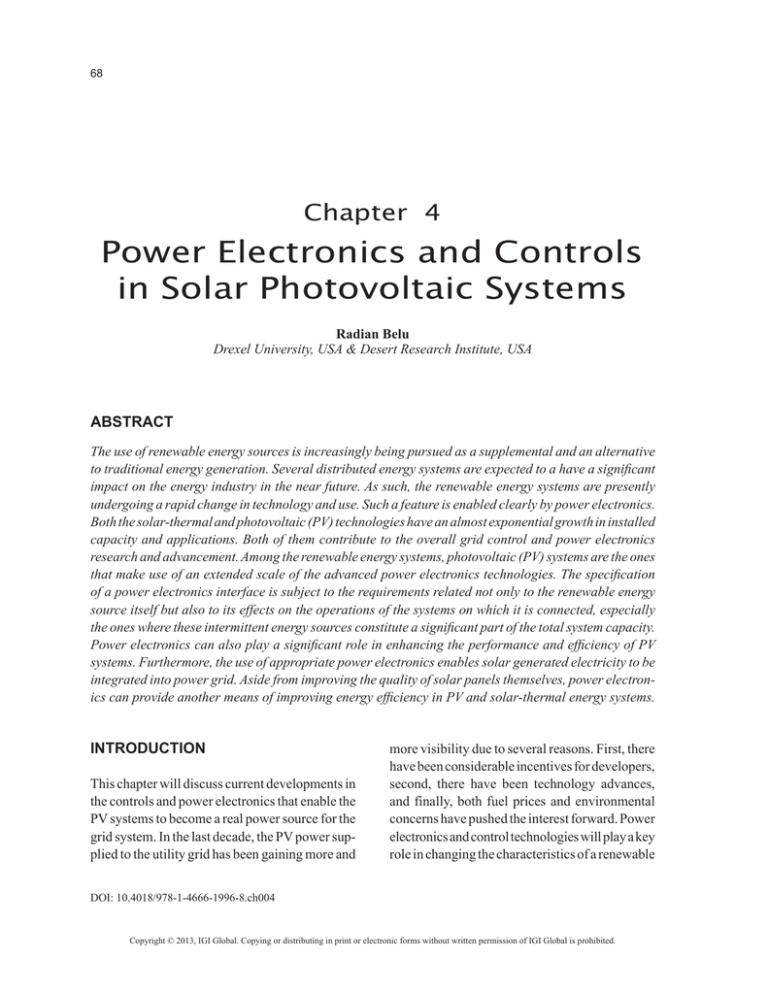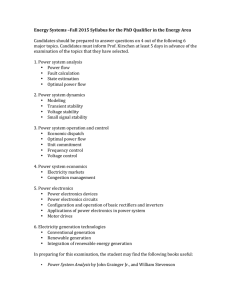Power Electronics and Controls in Solar Photovoltaic Systems
advertisement

68 Chapter 4 Power Electronics and Controls in Solar Photovoltaic Systems Radian Belu Drexel University, USA & Desert Research Institute, USA ABSTRACT The use of renewable energy sources is increasingly being pursued as a supplemental and an alternative to traditional energy generation. Several distributed energy systems are expected to a have a significant impact on the energy industry in the near future. As such, the renewable energy systems are presently undergoing a rapid change in technology and use. Such a feature is enabled clearly by power electronics. Both the solar-thermal and photovoltaic (PV) technologies have an almost exponential growth in installed capacity and applications. Both of them contribute to the overall grid control and power electronics research and advancement. Among the renewable energy systems, photovoltaic (PV) systems are the ones that make use of an extended scale of the advanced power electronics technologies. The specification of a power electronics interface is subject to the requirements related not only to the renewable energy source itself but also to its effects on the operations of the systems on which it is connected, especially the ones where these intermittent energy sources constitute a significant part of the total system capacity. Power electronics can also play a significant role in enhancing the performance and efficiency of PV systems. Furthermore, the use of appropriate power electronics enables solar generated electricity to be integrated into power grid. Aside from improving the quality of solar panels themselves, power electronics can provide another means of improving energy efficiency in PV and solar-thermal energy systems. INTRODUCTION This chapter will discuss current developments in the controls and power electronics that enable the PV systems to become a real power source for the grid system. In the last decade, the PV power supplied to the utility grid has been gaining more and more visibility due to several reasons. First, there have been considerable incentives for developers, second, there have been technology advances, and finally, both fuel prices and environmental concerns have pushed the interest forward. Power electronics and control technologies will play a key role in changing the characteristics of a renewable DOI: 10.4018/978-1-4666-1996-8.ch004 Copyright © 2013, IGI Global. Copying or distributing in print or electronic forms without written permission of IGI Global is prohibited. Power Electronics and Controls in Solar Photovoltaic Systems energy system to an active power source in the near future. The expected trends in power electronics and control technologies for solar energy systems are also discussed in this chapter. Renewable energy systems are presently undergoing a rapid change in technology and use. This rapidly growing interest in various aspects of clean energy is a reaction to the major energy-related challenges of the humanity. These efforts involve renewable energy sources, distributed generation systems, and conservation of energy in a variety of the electromechanical energy systems such as industrial drivers, electric and hybrid cars, etc. The renewable energy systems (RES) are now a major contributor to the grid power. In classical power systems large power generation plants located at adequate geographical places produce most of the power, which, is then transferred to the large consumption centers over long distance transmission lines. The system control centers monitor and regulate the power system continuously to ensure the quality of the power, namely frequency and voltage. However, now the overall power system is changing and a large number of dispersed generation (DG) units, including both renewable and non-renewable sources such as wind turbines, PV generators, fuel cells, etc. are being developed and installed. Solar energy alone has an almost exponential growth in installed capacity and applications in the last three decades. A widespread use of the renewable energy sources in distribution networks and a high penetration level will be seen in the near future in many places. To interface a renewable energy source efficiently to a load or grid the power electronic converters are performing power conditioning, voltage boosting, power flow control and power quality improvements. Power electronics has changed rapidly during the last decades and the number of applications has been increasing mainly due to the development of semiconductor devices and microprocessor technology. For both, higher performance has been steadily increasing for the same area of silicon, while at the same time, price has been continuously reducing. Power electronics, being the technology of efficiently converting electric power, plays an important role in the field of modern electrical engineering. It is an essential for the integration of the DG units in order to achieving high efficiency and performance. A power converter is the interface between a generator and the load or the grid. For most of the power converters, the power may flow in both directions, though this is dependent upon topology and applications. Three important issues are of concern using such systems, the reliability, the efficiency and the cost. In the last decades, the trends are that power electronic conversion is shrinking in volume, size and weight. It has also been shown that more integration and functions that are more available are the keys to being competitive. The key driver of this development is the advances in the device technology. This chapter presents several examples of power electronics and control applications in the PV/solar energy systems, both utility interactive systems and stand-alone systems. The most common power electronics topologies and control strategies for photovoltaics are discuessed in details. PV systems can be classified as follows: a) Stand-alone PV Systems; b) Hybrid Power Systems; and c) Grid Connvected or Intgrated Systems. Each type of system generally requires a power electronics interpace unit to enable the PV system to transfer solar cell generated electricity optimally to the desired load, grid or storage system. Power electronics and control unitis for PV systems are of two types: stand-alone and grid-connected. The two types have serveral similarities but they are different in terms of control functions. The intent of this chapter is to presnt the what, why and how of PV system control, power electronics and design. The use of power electronics in PV system is described in details. Conversion, control and monitoring of electric energy with the use of semiconductors are also described. Methods for analyzing convert- 69 56 more pages are available in the full version of this document, which may be purchased using the "Add to Cart" button on the publisher's webpage: www.igi-global.com/chapter/power-electronics-controls-solarphotovoltaic/69087 Related Content CuInGaSe Based Thin Films for Photovoltaic Solar Cells Harry Efstathiadis and Adam Filios (2013). Handbook of Research on Solar Energy Systems and Technologies (pp. 192-209). www.irma-international.org/chapter/cuingase-based-thin-films-photovoltaic/69090/ CFD Modeling of Bubbling Fluidized Beds of Geldart A Powders T. Pugsley, S. Karimipour and Z. Wang (2011). Computational Gas-Solids Flows and Reacting Systems: Theory, Methods and Practice (pp. 359-372). www.irma-international.org/chapter/cfd-modeling-bubbling-fluidized-beds/47499/ Graphene-Based Sensors for Monitoring Strain: A First-Principles Density Functional Theory Analysis M. Mirnezhad, R. Ansari, H. Rouhi and M. Faghihnasiri (2013). International Journal of Chemoinformatics and Chemical Engineering (pp. 74-83). www.irma-international.org/article/graphene-based-sensors-monitoring-strain/75224/ Energy and Exergy Analysis on Gasification Processes: A Preliminary Approach Edgardo Olivares Gómez, Renato Cruz Neves, Elisa Magalhães de Medeiros and Mylene Cristina Alves Ferreira Rezende (2015). Innovative Solutions in Fluid-Particle Systems and Renewable Energy Management (pp. 199-240). www.irma-international.org/chapter/energy-and-exergy-analysis-on-gasificationprocesses/132886/ The Prediction of the Performance of an Oil Reservoir by Proxy Model: A Case Study Allahyar Daghbandan and Seyed Mahdi Chalik (2015). International Journal of Chemoinformatics and Chemical Engineering (pp. 46-58). www.irma-international.org/article/the-prediction-of-the-performance-of-an-oil-reservoir-by-proxymodel/161818/



